Predictive Maintenance of Power Substation Equipment by Infrared Thermography Using a Machine-Learning Approach
Abstract
:1. Introduction
2. Predictive and Preventive Maintenance of Electrical Equipment
- Decreases the unscheduled shutdown
- Increases the suitable use of manpower
- Increases the output volume of the plants
- Decreases the management expenses of instruments
- Increases working life of devices
2.1. Predictive Maintenance of Electrical Equipment
2.2. Preventive Maintenance of Electrical Equipment
3. Artificial-Intelligence Defect-Identification Model for Power Substations: Proposed Approach
3.1. Thermal Image and Delta Temperature Criteria Analysis
3.2. Feature Extraction
3.3. ANN: Multilayered Perceptron (MLP)
4. Experimental Setup and Result Analysis
4.1. MLP-Based Defect Analysis
4.2. Graph and Graph-Cut Integration
4.3. MLP and Graph-Cut Results
5. Conclusions and Future Work
Acknowledgments
Author Contributions
Conflicts of Interest
Abbreviations
| IRT | Infrared thermography |
| ANN | Artificial neural network |
| MLP | Multilayer perceptron networks |
| SVM | Support vector machine |
| NETA | National Electrical Testing Association |
| NFPA | National Fire Protection Association |
| ASTM-E | American Society for Testing and Materials |
| RTF | Run to failure |
| MTTF | Mean time to failure |
| CB | Circuit breakers |
References
- Korendo, Z.; Florkowski, M. Thermography based diagnostics of power equipment. Power Eng. J. 2001, 15, 33–42. [Google Scholar] [CrossRef]
- Ge, Z.; Du, X.; Yang, L.; Yang, Y.; Li, Y.; Jin, Y. Performance monitoring of direct air-cooled power generating unit with infrared thermography. Appl. Therm. Eng. 2011, 31, 418–424. [Google Scholar] [CrossRef]
- Lahiri, B.B.; Bagavathiappan, S.; Jayakumar, T.; Philip, J. Medical applications of infrared thermography: A review. Infrared Phys. Technol. 2012, 55, 221–235. [Google Scholar] [CrossRef]
- Bougriou, C.; Bessäh, R.; Le Gall, R.; Solecki, J.C. Measurement of the temperature distribution on a circular plane fin by infrared thermography technique. Appl. Therm. Eng. 2004, 24, 813–825. [Google Scholar] [CrossRef]
- Balaras, C.A.; Argiriou, A.A. Infrared thermography for building diagnostics. Energy Build. 2002, 34, 171–183. [Google Scholar]
- Royo, R.; Albertos-Arranz, M.A.; Cárcel-Cubas, J.A.; Payá, J. Thermographic study of the preheating plugs in diesel engines. Appl. Therm. Eng. 2012, 37, 412–419. [Google Scholar] [CrossRef]
- Manana, M.; Arroyo, A.; Ortiz, A.; Renedo, C.J.; Perez, S.; Delgado, F. Field winding fault diagnosis in DC motors during manufacturing using thermal monitoring. Appl. Therm. Eng. 2011, 31, 978–983. [Google Scholar] [CrossRef]
- Titman, D.J. Applications of thermography in non-destructive testing of structures. NDT E Int. 2001, 34, 149–154. [Google Scholar]
- Al-Kassir, A.R.; Fernandez, J.; Tinaut, F.V.; Castro, F. Thermographic study of energetic installations. Appl. Therm. Eng. 2005, 25, 183–190. [Google Scholar]
- Jadin, M.S.; Taib, S. Recent progress in diagnosing the reliability of electrical equipment by using infrared thermography. Infrared Phys. Technol. 2012, 55, 236–245. [Google Scholar]
- Lizak, F.; Kolcun, M. Improving reliability and decreasing losses of electrical system with infrared thermography. Acta Electrotech. Inf. 2008, 8, 60–63. [Google Scholar]
- Gill, P. Electrical Power Equipment Maintenance and Testing; CRC Press: Boca Raton, FL, USA, 1988. [Google Scholar]
- Chou, Y.-C.; Yao, L. Automatic Diagnostic System of Electrical Equipment Using Infrared Thermography. In Proceedings of the SOCPAR ’09 International Conference of Soft Computing and Pattern Recognition, Malacca, Malaysia, 4–7 December 2009. [Google Scholar]
- Infraspection Institute. Standard for Infrared Inspection of Electrical Systems & Rotating Equipment; Infraspection Institute: Burlington, NJ, USA, 2008; pp. 1–18. [Google Scholar]
- National Fire Protection Association (NFPA). NFPA 750 Standard on Water Mist Fire Protection Systems 2006 Edition; Style (DeKalb, IL); National Fire Protection Association: Quincy, MA, USA, 2006. [Google Scholar]
- ASTM E1934—99a(2014) Standard Guide for Examining Electrical and Mechanical Equipment with Infrared Thermography. Available online: https://www.astm.org/Standards/E1934.htm (accessed on 22 September 2017).
- Manduchi, G.; Marinetti, S.; Bison, P.; Grinzato, E. Application of neural network computing to thermal non-destructive evaluation. Neural Comput. Appl. 1997, 6, 148–157. [Google Scholar] [CrossRef]
- Darabi, A.; Maldague, X. Neural network based defect detection and depth estimation in TNDE. NDT E Int. 2002, 35, 165–175. [Google Scholar] [CrossRef]
- Laurentys Almeida, C.A.; Braga, A.P.; Nascimento, S.; Paiva, V.; Martins, H.J.A.; Torres, R.; Caminhas, W.M. Intelligent thermographic diagnostic applied to surge arresters: A new approach. IEEE Trans. Power Deliv. 2009, 24, 751–757. [Google Scholar] [CrossRef]
- Shafi’I, M.A.; Hamzah, N. Internal fault classification using artificial neural network. In Proceedings of the 2010 4th International Power Engineering and Optimization Conference (PEOCO), Shah Alam, Malaysia, 23–24 June 2010; pp. 352–357. [Google Scholar]
- Rahmani, A.; Haddadnia, J.; Seryasat, O. Intelligent fault detection of electrical equipment in ground substations using thermo vision technique. In Proceedings of the 2010 2nd International Conference on Mechanical and Electronics Engineering (ICMEE), Kyoto, Japan, 1–3 August 2010; pp. V2-150–V2-154. [Google Scholar]
- Smedberg, M. Thermographic Decision Support—Detecting and Classifying Faults in Infrared Images. Master’s Thesis, Royal Institute of Technology, Stockholm, Sweden, 2006. [Google Scholar]
- Wretman, D. Finding Regions of Interest in a Decision Support System for Analysis of Infrared Images. Master’s Thesis, Royal Institute of Technology, Stockholm, Sweden, 2006. [Google Scholar]
- Huda, A.S.N.; Taib, S. Application of infrared thermography for predictive/preventive maintenance of thermal defect in electrical equipment. Appl. Therm. Eng. 2013, 61, 220–227. [Google Scholar] [CrossRef]
- Mendes, M.A.; Tonini, L.G.R.; Muniz, P.R.; Donadel, C.B. Thermographic analysis of parallelly cables: A method to avoid misdiagnosis. Appl. Therm. Eng. 2016, 104, 231–236. [Google Scholar] [CrossRef]
- Huo, Z.; Zhang, Y.; Sath, R.; Shu, L. Self-adaptive fault diagnosis of roller bearings using infrared thermal images. In Proceedings of the 43rd Annual Conference of the IEEE Industrial Electronics Society (IECON 2017), Beijing, China, 29 October–1 November 2017. [Google Scholar]
- Jeffali, F.; El Kihel, B.; Nougaoui, A.; Delaunois, F.; Manssouri, I. Thermal diagnotic of a rotating machine using the nondestructive technique of infrared thermogrphy. J. Nat. Sci. Sustain. Technol. 2015, 10, 219–232. [Google Scholar]
- Łopata, S.; Kocot, M. The conditions for thermographic testing of thermal power engineering installations. Czasopismo Techniczne 2017, 10, 179–192. Available online: http://www.ejournals.eu/Czasopismo-Techniczne/ (accessed on 28 November 2017).
- Liu, H.; Xie, T.; Ran, J.; Gao, S. An Efficient Algorithm for Server Thermal Fault Diagnosis Based on Infrared Image. J. Phys. Conf. Ser. 2017, 910, 012031. [Google Scholar] [CrossRef]
- The Basics of Predictive/Preventive Maintenance—Google Search. Available online: assets.tequipment.net/assets/1/26/Documents/Ti30predictive_maint.pdf (accessed on 2 July 2017).
- Fluke Corporation. The Basics of Predictive/Preventive Maintenance; Fluke Corporation: Everett, WA, USA, 2005; pp. 1–6. [Google Scholar]
- FLIR Advanced Thermal Solutions: FLIR T600 Series Infrared Cameras for Research & Science. Available online: http://www.flir.com/science/display/?id=46818 (accessed on 22 September 2017).
- Haykin, S. Neural Networks: A Comprehensive Foundation, 1st ed.; Herrmann, M., Bauer, H.-U., Der, R., Eds.; IEEE Press: New York, NY, USA, 1994; pp. 107–116. [Google Scholar]
- Schaffer, C. Selecting a classification method by cross-validation. Mach. Learn. 1993, 13, 135–143. [Google Scholar] [CrossRef]
- Boykov, Y.; Kolmogorov, V. An experimental comparison of min-cut/max-flow 193 algorithms for energy minimization in vision. IEEE Trans. Pattern Anal. Mach. Intell. 2004, 26, 1124–1137. [Google Scholar] [CrossRef] [PubMed]
- Micusík, B.; Hanbury, A. Automatic image segmentation by positioning a seed. Eur. Conf. Comput. Vis. 2006, 3952, 468–480. [Google Scholar]

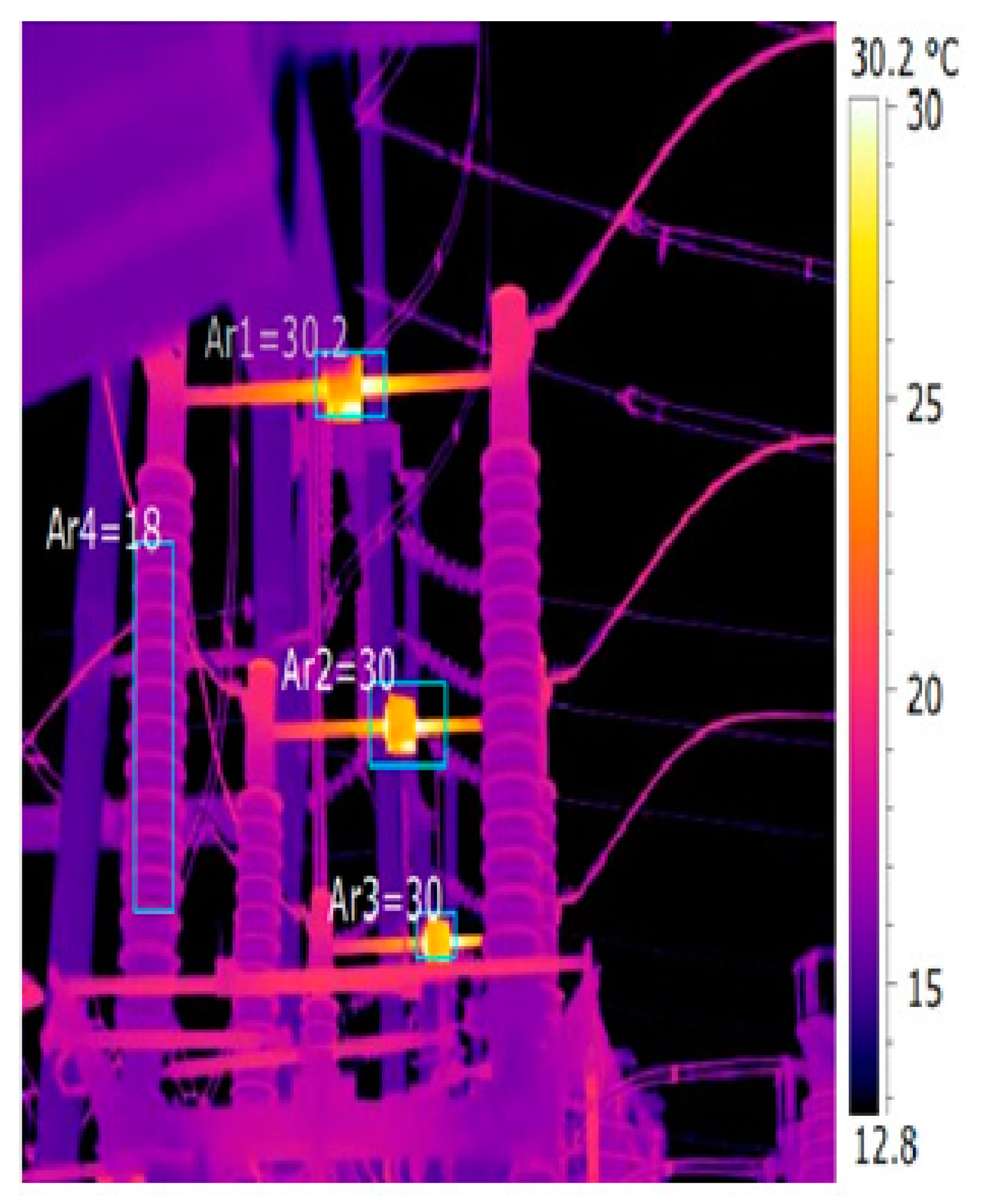
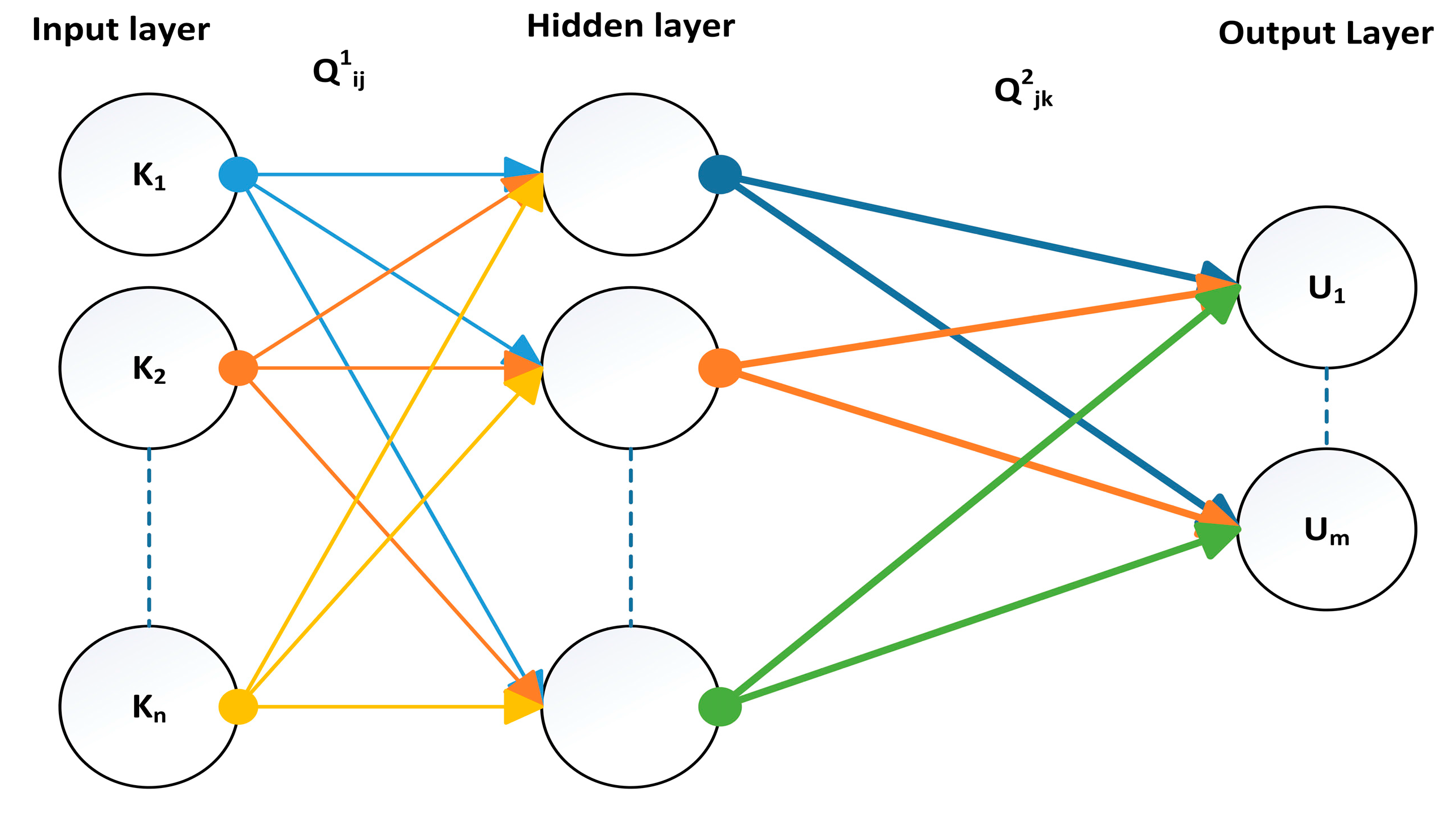
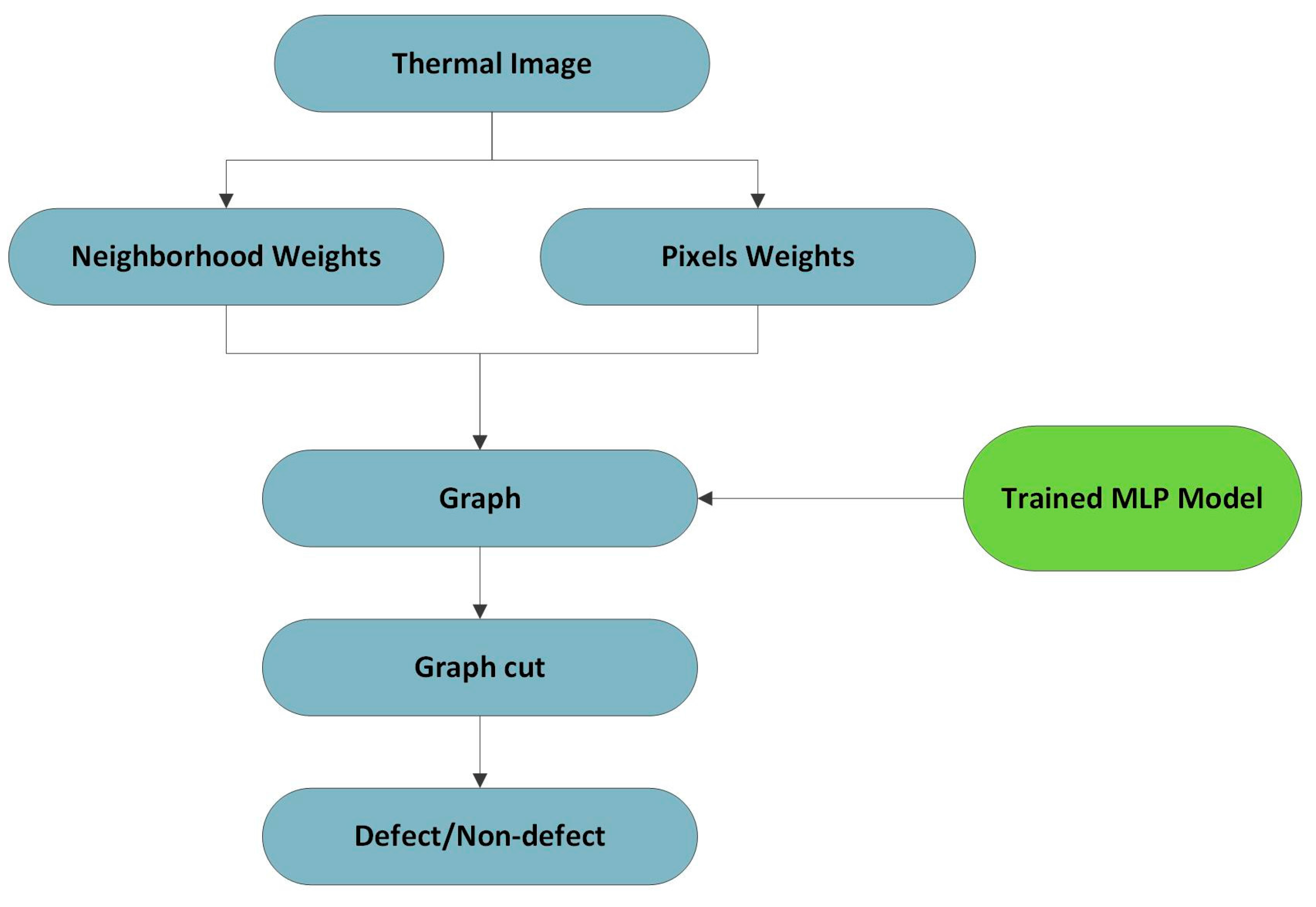
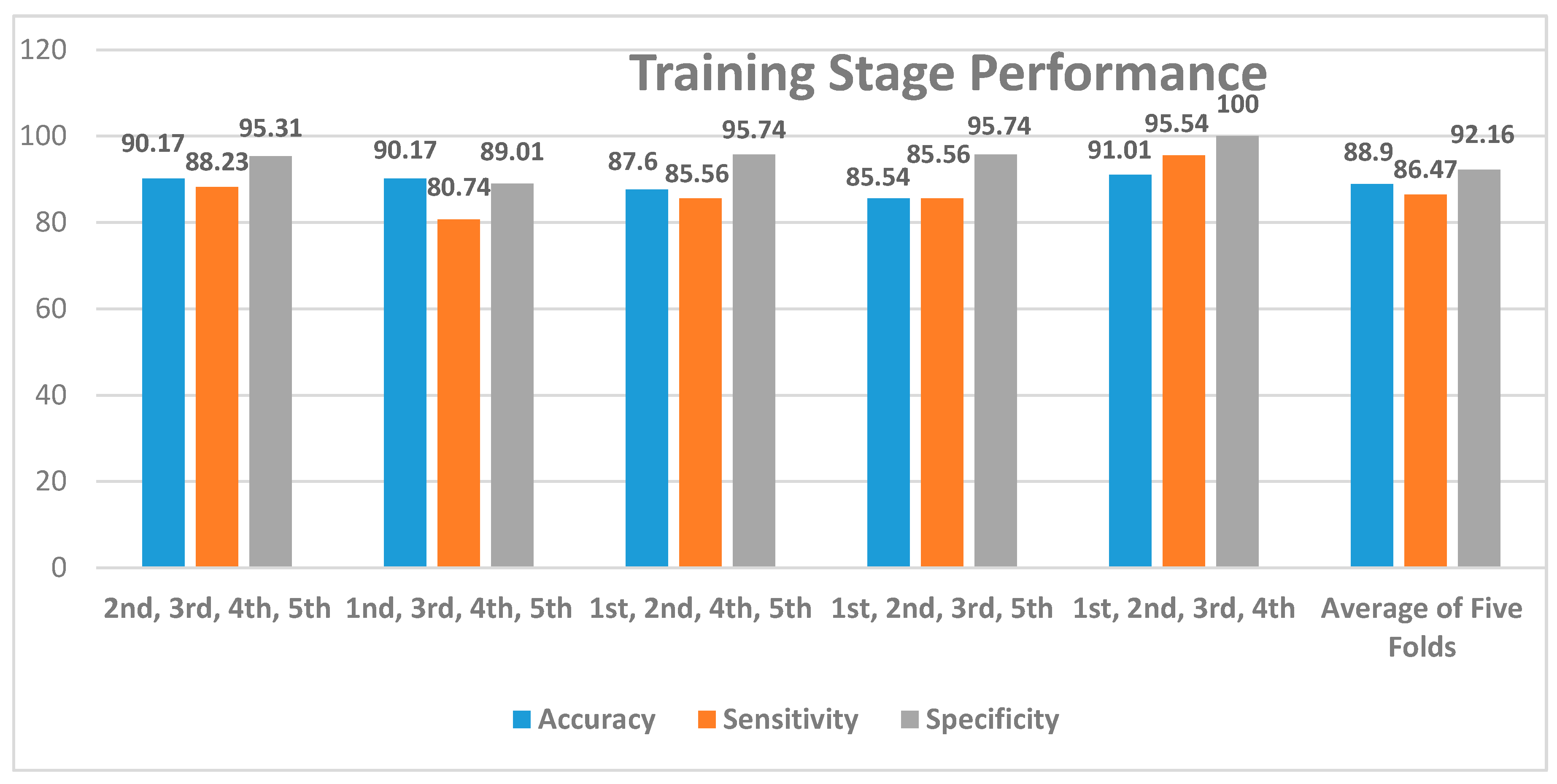
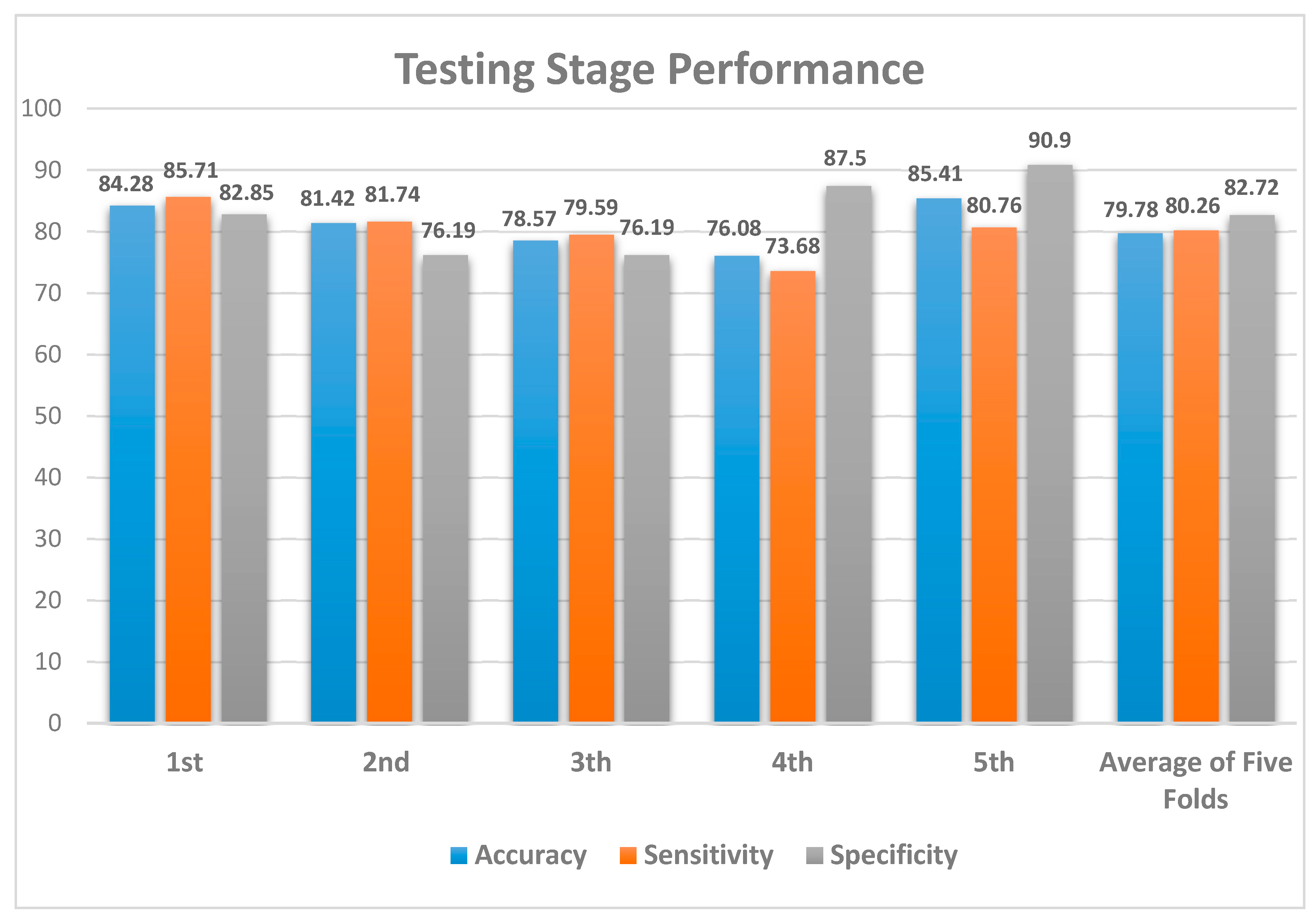

| Class of Equipment | ΔT (°C) | Recommended Suggestions |
|---|---|---|
| Non-Defective Equipment Defective Equipment | <16 >25 16 < T < 25 | Normal equipment section Defected area of equiment, repair instantly Minor defect, check on specific area of equipment |
| Feature Kind | Feature | Abbreviation |
|---|---|---|
| First-order histogram-based features | Mean | B1 |
| Variance | B2 | |
| Standard deviation | B3 | |
| Skewness | B4 | |
| Kurtosis | B5 | |
| Energy | B6 | |
| Entropy | B7 | |
| Gray-Level Co-Occurrence Matrix (GLCM) features | Contrast | B8 |
| Correlation | B9 | |
| Homogeneity | B10 | |
| Energy | B11 |
| Folds | Defect Class | Non-Defect Class | Total |
|---|---|---|---|
| 1st Fold | 50 | 20 | 70 |
| 2nd Fold | 60 | 10 | 70 |
| 3rd Fold | 40 | 30 | 70 |
| 4th Fold | 30 | 15 | 45 |
| 5th Fold | 20 | 25 | 45 |
| Total | 200 | 100 | 300 |
© 2017 by the authors. Licensee MDPI, Basel, Switzerland. This article is an open access article distributed under the terms and conditions of the Creative Commons Attribution (CC BY) license (http://creativecommons.org/licenses/by/4.0/).
Share and Cite
Ullah, I.; Yang, F.; Khan, R.; Liu, L.; Yang, H.; Gao, B.; Sun, K. Predictive Maintenance of Power Substation Equipment by Infrared Thermography Using a Machine-Learning Approach. Energies 2017, 10, 1987. https://doi.org/10.3390/en10121987
Ullah I, Yang F, Khan R, Liu L, Yang H, Gao B, Sun K. Predictive Maintenance of Power Substation Equipment by Infrared Thermography Using a Machine-Learning Approach. Energies. 2017; 10(12):1987. https://doi.org/10.3390/en10121987
Chicago/Turabian StyleUllah, Irfan, Fan Yang, Rehanullah Khan, Ling Liu, Haisheng Yang, Bing Gao, and Kai Sun. 2017. "Predictive Maintenance of Power Substation Equipment by Infrared Thermography Using a Machine-Learning Approach" Energies 10, no. 12: 1987. https://doi.org/10.3390/en10121987




